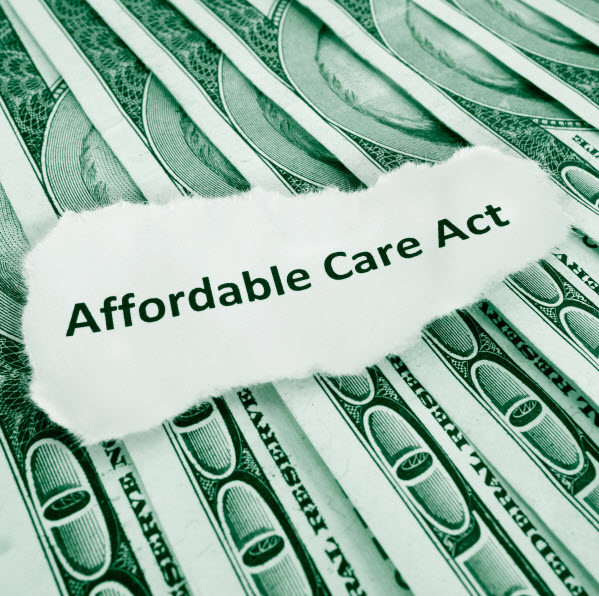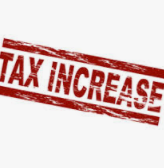
Under the Affordable Health Care Act (ACA), individuals who purchase health care coverage through an exchange and whose income is under certain amounts will be eligible for tax credits. Form 8962 will be used to enter any advance credits received and amounts entitled to for the current tax year. The net amount (credit entitled to less the advance credit) is then entered on a separate line on the back of Form 1040 or 1040A. Taxpayers who claim the credit cannot file Form 1040 EZ (for AGI less than $100,000 and do not itemize and don’t have any dependents) but must file Form 1040 or 1040A. If you are eligible for the credit, you can choose to:
• Get it now: have some or all of the estimated credit paid in advance directly to your insurance company to lower what you pay out-of-pocket for your monthly premiums.
• Get It later: wait to get the credit when you file your tax return.
During enrollment through the Marketplace, using information you provide about your projected income and family composition for the year, the Marketplace will estimate the amount of the premium tax credit you will be able to claim on your tax return. You will then decide whether you want to have all, some or none of your estimated credit paid in advance directly to your insurance company or take it when you file your tax return.
Amount of the Credit
More detail can be found at www.gpo.gov/fdsys/pkg/FR-2012-05-23/pdf/2012-12421.pdf.
[Also see rules and regulations for the ACA in the Federal Register Vol 77, No. 100, May 23, 2012].
Individuals:
According to IRS regulations under Sec. 36B(c)(1)(c) married taxpayers must file a joint return to claim the credit. But an exception is made to allow spouses to file a separate return and claim the credit in situations involving an incarcerated spouse, separation due to abuse, and a pending divorce.
The amount of the premium assistance for a coverage month is the lesser of
(1) the premiums for the month for one or more qualified health plans in which a taxpayer or a member of the family enrolls or
(2) the excess of the adjusted monthly premium for the applicable benchmark plan in excess of ½ of household income (AGI plus foreign-earned income and tax-exempt interest) multiplied by the applicable percentage for the taxable year. The adjusted monthly premium is the premium an issuer would charge for the applicable benchmark plan to cover all members of the taxpayer’s family under a plan, adjusted for the age of each family member covered as allowed under section 2701 of the Public Health Service Act [42 U.S.C. 300gg]. This premium is determined disregarding any premium discount or rebate under section 2705(d) of the Public Health Service Act [42 U.S.C. 300gg-4(d)] and may not include adjustments for tobacco use. The applicable benchmark plan is defined as the second lowest silver plan described in Sec. 1302(d)(1)(B) of the ACA for individuals or families offered through the “Abomey Care Exchange” for the rating area where the taxpayer resides. Taxpayers must verify to the IRS what their income is. If they cannot do so, all or part the credit will have to be repaid.
Self-Employed
For more details see Rev Proc. 2014-41 effective for years starting in 2014. This pronouncement provides guidance for taxpayers to compute the health insurance deduction under Sec. 162 and the premium credit allowed under Sec. 36B.
Deduction [Reg. 1.162(1)-1T(a)(1)]:
A self-employed individual may be allowed an ordinary business expense deduction for all or part of health care premiums paid during the tax year for the taxpayer, spouse, dependents, and any child under age 27. The deduction is limited to self-employment income and is treated as a deduction for AGI. The deduction for the specified premiums is limited to the lesser of:
(1) the premium paid, less the premium tax credit and
(2) the sum of the premiums not paid through advance credit payments and the additional tax imposed under Sec. 36B(f)(2)(A) and Reg. 1.36B-4(a)(1) with respect to the “specified premiums” after the limitation on additional tax imposed by Sec. 36B(f)(2)(B) and Reg. 1.36B-4(a)(3). “Specified premiums” are premiums for a specified health care plan or plans for which the taxpayer may otherwise claim a deduction under Sec. 162(1) and Reg. 1.136B-1(C) covering the taxpayer, spouse, and dependents for a month that is a coverage month within Reg. 1.136B-3(C) for the enrolled family members. If non-enrolled family members are covered, the specified premiums include only the portion of the premiums for covered family members. Specified premiums not paid through advance credit payments equal the amount of the specified premiums minus the advance credit payments [Reg. 1.162(1)-T(a)(3)].
Limitation:
The deduction can’t exceed the lesser of:
(1) earned income from the trade or business within the meaning of Sec. 401(c)
(2) the sum of (a) specified premiums not paid through advance credit payments and
(3) the limitation on additional tax determined under Reg. 1.36B-4(a)(3)(iii).
Premium Credit
A credit (subsidy) is allowed for all or part of health care premiums paid by an individual or an employer for the taxpayer, spouse, dependents, and any child under age 27.
Individuals
Eligibility:Individuals must satisfy three rules:
(1) obtain your health insurance coverage through the Health Insurance Marketplace (a federal or state exchange).
(2) have household income between one and four times the federal poverty line. For a family of four for tax year 2014, that is income from $23,550 to $94,200.
(3) you can’t be eligible for other coverage, such as Medicare, Medicaid, or employer-sponsored coverage.
If a Marketplace determines that you’re likely to qualify for the tax credit at the time you enroll, you have two choices: (1) choose to have some or all of the estimated credit paid in advance directly to your insurance company to lower what you pay out-of-pocket for your monthly premiums during 2014 and later years, or (2) wait to get all of the credit when you file your tax return. If you take the credit on your tax return, it will increase your refund or lower your balance due.
If you choose to receive the credit in advance, changes in your income or family size will affect the credit that you are eligible to receive. If the credit on your tax return you file in 2015 does not match the amount you have received in advance, you will have to repay any excess advance payment, or you may get a larger refund if you are entitled to more. It is important to tell your Marketplace about changes in your income or family size as they occur because these changes will affect the amount of your credit [IRS Health Care Tax Tip 2014-03, February 25, 2014].
Small Businesses (non-self employed)
The IRS provides an estimator calculator to determine the allowed amount. See http://www.taxpayeradvocate.irs.gov/calculator/SBHCTC.htm.
The information below is taken from “What You Need to Know about the Small Business Health Care Tax Credit” by the IRS [http://www.irs.gov/uac/Small-Business-Health-Care-Tax- Credit-for-Small-Employers].
Eligibility:
The employer must cover at least 50% of the cost of employee only (not family nor dependents) health care coverage for each employee. The employer must also have fewer than 25 full-time equivalent (FTE) employees and their average annual wages must be less than $50,000 as adjusted for inflation starting in 2014. The insurance must be purchased through the Small Business Health Options Program Marketplace.
Examples:
(1) FTE’s: Two half-time employees are considered as one FTE. If you have 20 half-time employees, you are considered to have 10 FTE’s.
(2) Average annual wages: An employer pays total annual wages of $200,000 and has10 FTE’s. The annual average wage is $20,000 [$200,000 divided by 10].
Amount of the Credit:
For years 2010 through 2013, the maximum credit was 35% of premiums paid and 25% for small tax-exempt businesses. Starting in 2014, the maximum credit is 50% of premiums paid by taxable small businesses and 35% for tax-exempt employers. To be eligible for the credit, a small businesses employer must pay premiums on behalf of employees enrolled in a qualified health program offered through a Small Business Health Options Program Marketplace or qualify for an exception. The credit is available for two consecutive years. The amount is based on a sliding scale. The smaller the business or charity, the larger the credit. The amount is based on “household income” multiplied by an applicable percentage specified in the regulations using Form 8941 Credit for Small Employee Health Insurance Premiums. The credit is claimed as part of the “general business credit” on the tax return
Unused credits:
If an employer does not owe tax in a particular year, the eligible credit can be carried back or forward to other tax years. If the health care premiums exceed the credits, the business can still claim a business expense deduction for the premiums that exceed the credits. Thus, the business can receive both a deduction and a credit for employee health care premiums.
If the small business is a tax exempt organization (e.g., a charity), and has no taxable income, the credit is refundable.
If a business failed to claim the credit in a particular year, an amended return may be filed to claim it.
Claiming the Credit on Your Federal Tax Return
Individuals
For any tax year, if you receive advance credit payments or claim the premium tax credit, you must file a federal income tax return for that year. If you choose to get the advance credit, when you file your tax return, you will subtract the advance payments from the amount of the premium tax credit calculated on your tax return. If the premium tax credit computed on the return is more than the advance payments made on your behalf during the year, the difference will increase your refund or lower the amount of tax you owe. If the advance credit payments are more than the premium tax credit, the difference will increase the amount you owe or reduce the refund. If you choose not to take an advance credit, you will claim the full amount of the premium tax credit on your tax return. This will either increase your refund or lower your balance due.
Income limits:
In general, individuals and families whose household income for the year is between 100 percent and 400 percent of the federal poverty line for their family size may be eligible for the premium tax credit. An individual who meets these income requirements must also meet the other eligibility criteria specified in the regulations. Thus, if you have household income between 100 percent and 400 percent of the federal poverty line, but are eligible for coverage through your state’s Medicaid program (for example, because your state provides Medicaid to individuals with household income up to 133 percent of the federal poverty line), you are not eligible for the premium tax credit.
Businesses
To compute the credit, a taxable business uses Form 8941 Credit for Small Employee Health Insurance Premiums. For taxable small businesses, the credit is claimed as part of the “general business credit” on the tax return. A non-taxable business includes the amount on line 44 of Form 990-T.
Change in Circumstances
You must report income and family size changes to the Marketplace throughout the year ro ensure you get the proper type and amount of premium credit and will help you avoid getting too much or too little in advance. Receiving too much or too little in advance can affect your refund or balance due when you file your tax return. For example, if you do not report income or family size changes to the Marketplace when they happen, the advance payments may not match your actual qualified credit amount on your federal tax return resulting in a smaller refund or balance due.
Recent Litigation Affecting Premium Credits
Under the ACA, subsidies (premium credits) are limited to policies purchased on state exchanges. On September 30, 2014, this was upheld by Justice Ronald White of the Oklahoma Federal District Court in the case Oklahoma vs. Burwell. Justice White stated that “federal subsidies are nowhere authorized in the Affordable Care Act” [and] the Administration cannot ignore the plain text of the Affordable Care Act which limits insurance subsidies to exchanges established by states whose dollars are sent out through the 36 federal exchanges.” He further stated “the court is upholding the Act {ACA} as written. Congress is free to amend the ACA to provide for extra tax credits in both federal and state exchanges, if that is the legislative will.” His order is stayed pending appeal to Tenth Circuit Court of Appeals. Judge White also invoked a 1998 Tenth Circuit precedent called Sundance Associates vs. Reno which held that “neither judges nor regulatory agencies possess the authority to rewrite a poor piece of legislation . . . . That responsibility lies solely with Congress. The alternative leads us down a path toward Alice’s Wonderland, where up is down and down is up, and words mean anything” [“Obama Care’s Wonderland”, editorial in The Wall Street Journal, October 2, 2014].
Previously, a partial court of the D.C. Circuit Court of Appeals reached the same conclusion in the Halbig case but was later vacated by the enbanc court. Recently, in the King case, the Fourth Circuit upheld the federal subsidies. This decision has been appealed to the Supreme Court. The Court will decide in mid October whether to accept the appeal.
Other federal courts have made conflicting rulings. As a result of these conflicting decisions, for the benefit of the law and future of health care, the Supreme Court will likely decide which of these various decisions are the relevant one. Until the Court renders a decision, premium credits for policies purchased on a federal exchange are in jeopardy for taxpayers residing in parts of the country under the jurisdiction of courts ruling that premium credits are illegal for policies purchased on a federal exchange.
For more information and a detailed analysis of the courts reasons for their decision in the above cases, see “Analysis of and reflections on recent cases and rulings” by James A. Beavers, J.D., LLM, CPA, CGMA, The Tax Adviser, October 2014.




















1 comment on “Premium Credits Under The Affordable Health Care Act”
That is very interesting information thank you for posting it.
Comments are closed.